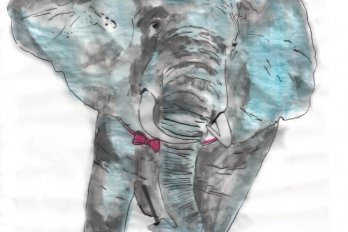NAIROBI — We’re two drinks into slam poetry night when Njeri Wangari takes the stage. Her dreadlocks, tied up with a purple scarf, lend her an imperious air as she surveys the dimly lit restaurant. An unruly crowd of kauzis and babis (more on that in a moment) is crammed around the knee-high tables, tripping up the cameramen and emitting a steady murmur. Nairobi likes to talk. After all, Kenya has forty-two languages to choose from — make that forty-three with the recent emergence of Sheng.
Wangari deploys some Sheng in her opening piece, about matatus, the notorious hip hop–blaring Nissan minivans that serve as Nairobi’s primary form of public transport. Those damn “tariffs that change like a woman’s moods,” she laments.
True that, nods the crowd.
“Manze ngoja kwanza niwarm kiti” (“Chill and let me warm my seat”), she intones, fending off an imaginary tout.
Been there.
“Manze jo! Skia hii story!” (“Yo! Listen to this story!”) For all their faults, it was on these infernal matatus that “unto us, a Sheng was born.”
Overly solemn, perhaps, but then such births are rare in the modern world. The planet’s 6,000-plus species of language are undergoing a wave of extinction proportional to the one wiping out Sumatran tigers and Yangtze dolphins. Half the world’s languages are spoken by 10,000 or fewer people, over a quarter by fewer than 1,000. At the present rate of decline, our grandchildren will have half as many tongues as we do in which to tell their stories.
Is the merger of Kenya’s forty-two into a single Sheng truly cause for celebration? Depending on whom you ask, Sheng can elicit disgust (from the government and teachers), fatalism (linguists), or pride of ownership (everyone under thirty). The same can be said of the matatus Wangari describes, which, aside from high-risk transport, offer millions of ghetto youths the same delights their Western counterparts find in a mall: a place to check each other out, hear new beats, whatever. Listening to their shouts, whispers, and catcalls as they shuttle through the city, it’s clear that matatus are incubating the one language in which every youth can rhyme.
That, in turn, has made Sheng marketable. The organizer of tonight’s poetry slam, the colourful Buddha Blaze, is a major promoter of Kenya’s hip hop scene, which has played a key role in pushing the language into the mainstream. Blaze lurks near the entrance, fluorescent shoes on his feet, far enough from the stage that he can talk comfortably. “In the ’90s, artists were booed off the stage for rapping in Sheng,” he tells me. “Now that’s all people want to hear. You rhyme in Sheng, and you’re cool.”
At the front of the room, Wangari delivers her second-round poem in unadulterated English. The crowd grows indifferent. She’s supplanted by Dan Oballa, a boisterous Luo who unleashes his mujojo on us, telling of the trouble it keeps getting him into. He embellishes his Sheng by holding his fist at hip level and thrusting it forward, in imitation of his wayward member. Not quite T. S. Eliot, but the audience is howling. He goes on to tie for first place.
“Sheng really livens up a performance,” Oballa says after the show, as though his fist had nothing to do with it. “It’s very natural, a language of connection.” Wangari, sitting beside him and gracious in defeat, nods.
“There are some stories you just can’t tell without Sheng,” she says. “I had to use it to recreate the matatu vibe. The problem with Sheng is that it has such a short shelf life. Words change so fast that if you write down a poem, a year later it just sounds old school. Besides, you can’t use it to talk about anything serious.”
“That’s not true,” says Oballa. “You could talk about police harassment. That’s serious.”
It’s also appropriate. Sheng is largely a language of rebellion. Its story parallels the rise of a new generation, born into poverty and automatically at odds with authority. It crystallized in a young Kenya, nearly twenty years old at the start of the 1980s, and hosting the fastest-growing population on the planet. Classrooms were exploding far beyond capacity, producing a half-educated generation with fading mother tongues and a mediocre grasp of Swahili and English, the country’s two official languages. Their young minds seized the material at hand and wove it into S(wa)h(ili)Eng(lish).
The ’80s were also a decade of agricultural and economic collapse. Millions of Kenyans from disparate tribal homelands swarmed the hostile city, rubbing shoulders and dialects in slums that rapidly overwhelmed Nairobi. Unemployment doubled, with a corresponding rise in crime, and by the ’90s Kenya’s capital was no longer the Green City in the Sun; it had become Nairobbery. Sheng, meanwhile, expanded to embrace Kenya’s forty other languages, leaving its foundational duo with a mere 30 percent stake in its vocabulary.
The language took root not only among the kauzis (derived from the Swahili words for “petty thief” and “to harden”), the half of Nairobi’s 3.3 million people who call the slums home, but also with the babis (named after Babylon, the home of decadence in reggae parlance), denizens of the city’s gated communities. The babis’ leafy estates connect with the kauzis’ mud shacks through a thousand daily interactions: buying mangoes in the market, ordering a servant, squeezing into the matatus in which all but the wealthiest ride. No matter who’s aboard, on a given trip across the city you can follow “Mother” as she becomes “Matha,” then “Masa,” until finally the poor woman has been inverted to become “Sama.” Father has it easier: he’s just plain Buda, named after that Indian fellow.
And speaking of Buddha, I find him once more at the end of the night. The promoter is checking ticket sales in the stairwell, pleased with the result and happy to pontificate on the unifying powers of Sheng. “From a plane,” he says, “Nairobi just looks like one big-ass ghetto. Truth is, people from Eastlands ain’t that different from people in Westlands. Sheng is the signature of us all.”





